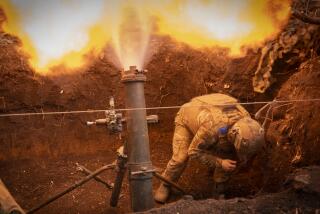Defense Buildup Is Expected to Be Gradual and Targeted
- Share via
Although defense stocks continued to rally on Wall Street on Monday with investors anticipating a large military buildup, many contractors said the conflict in Afghanistan has so far had little in common with the heady defense-spending days of the Gulf War.
Whereas many defense contractors were deluged with new orders or requests to step up production during Operation Desert Storm, many companies said the response from their military customers in the wake of the U.S. airstrikes Sunday has been muted.
Some companies have heard virtually nothing from their customers, although many say they have been getting lots of inquiries but no orders.
“When Desert Storm kicked in, the phones were ringing off the hook,” an executive with a small Southern California defense contractor said. “But we haven’t seen any evidence of turn-ons or accelerated production. It’s hard to imagine a conflict is going on.”
Industry analysts said increases in spending are likely to mirror the U.S.’ deliberate strategy--which took nearly a month of careful preparation and political negotiations--in responding to the Sept. 11 terrorist attacks.
Unlike the broad-based sudden surge in defense spending seen during the Persian Gulf War, weapons procurement this time around is expected to be gradual and targeted toward specific programs.
Although contractors may be impatient with the pace of spending, analysts said the latest conflict is likely to lead to prolonged benefit to the industry because spending will be larger and sustained compared with the short-lived spike in spending during the 1991 Gulf War.
“I would be a little surprised if there is much of an impact at this point,” said James F. Southerland, a defense contract expert with Contract Advisory Services Inc. “It’s not much like Kuwait, where we sent 50,000 troops and they needed support and housing. We aren’t going to see those quick contracts.”
The military buildup this time will be more like that seen during the Reagan administration in the early 1980s, one of the largest in U.S. history, said Paul H. Nisbet, defense analyst with JSA Research Inc., a Newport, R.I., research firm for institutional investors.
Nisbet noted that the Iranian hostage situation at the time combined with prior years of weak arms procurement set the stage for a military buildup.
Nisbet estimates the defense budget will rise by $50 billion to about $350 billion in the current fiscal year and then to $400 billion next year. “All the cards are in the row, and America’s public opinion is in favor of spending more for defense.”
Investors seem to agree with the long-term prospects. Defense stocks have been rising since the Sept. 11 attacks and surged again Monday with the U.S. launching attacks on targets in Afghanistan.
Northrop Grumman Corp. closed at a three-year high of $107.60, up 10 cents, in New York Stock Exchange trading. Los Angeles-based Northrop makes the Global Hawk unmanned spy plane, which the Air Force is pushing to deploy and already may be flying over Afghanistan. It also makes electronic jamming devices and surveillance equipment expected to be used there.
Among other defense giants, General Dynamics rose $2.39 to a record $94.99 on the NYSE.
The biggest percentage gainer in the sector was Raytheon Co., maker of the Tomahawk cruise missiles that were part of the strike Sunday. The stock rose $1.33, or 3.8%, to $36.30 on the NYSE. In addition to cruise missiles, Raytheon also builds sensors and radars used on unmanned and manned reconnaissance airplanes that are being used extensively in Afghanistan to find targets and then provide assessments after a strike.
One reason suppliers and contractors aren’t seeing a surge in new orders yet is that the U.S. had built up a stockpile of weapons, including gravity bombs and cruise missiles, that are being used to strike targets in Afghanistan.
“A number of them are getting probes about potentially accelerating programs, particularly related to information technology, but they aren’t receiving new orders,” said Jon B. Kutler, president of Quarterdeck Investment Partners Inc. “This war is still being fought with reserves.”
James J. Peterson, president of Microsemi Corp. in Irvine, which makes components that go on nearly all weapons the military uses, from tanks and fighter jets to missiles and radar, said the company is anticipating a major boost as the military looks to replenish its resources.
“Over the last couple of weeks, we’ve seen interest in some of our products that we haven’t seen in years,” Peterson said. “Inquiries for our type of products have increased, but we haven’t been able to quantify it.”
More to Read
Inside the business of entertainment
The Wide Shot brings you news, analysis and insights on everything from streaming wars to production — and what it all means for the future.
You may occasionally receive promotional content from the Los Angeles Times.










